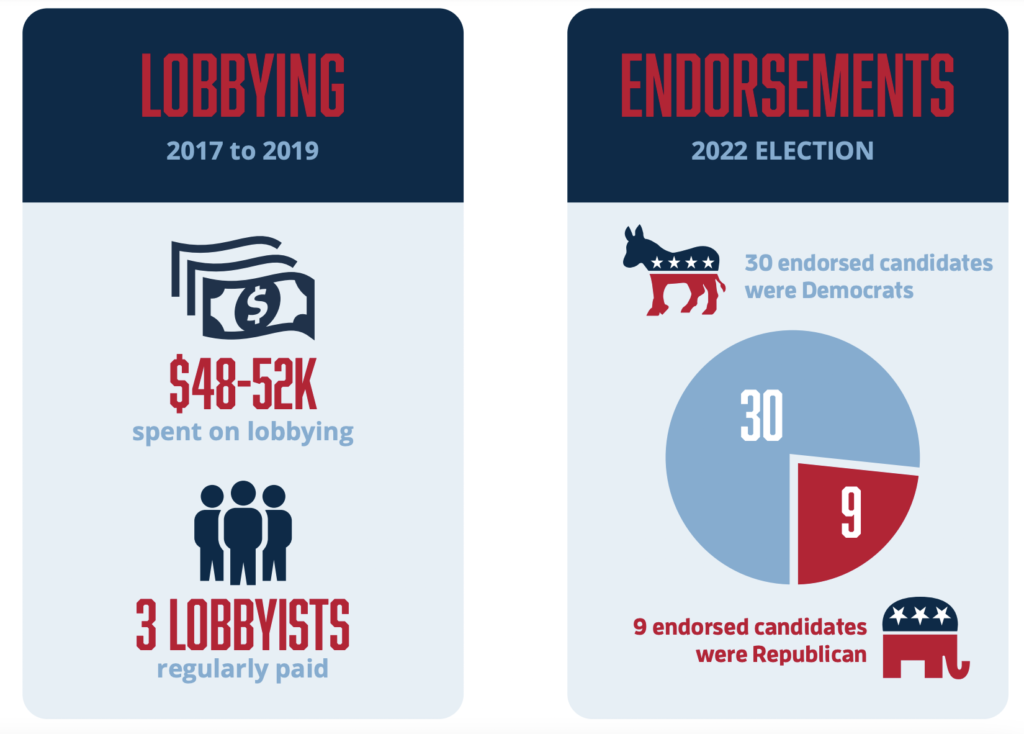A LOOK AT AFT SPENDING IN THE 2019 FISCAL YEAR
The South Carolina Education Association (SCEA) is the leading teachers’ union in South Carolina. Unlike many unions, the SCEA cannot represent its members in collective bargaining. As the South Carolina Supreme Court found in Branch v. City of Myrtle Beach (2000), “public employees in South Carolina do not have the right to collective bargaining.” Despite this, the SCEA still collects membership dues.
As a nonprofit, the SCEA must file a financial disclosure form
with the Internal Revenue Service, known as a Form 990. In 2019, the latest available filing, the SCEA brought in just over $1.7 million in revenue. This represents a sharp decrease from 2017 and 2018, both of which saw about $2 million in revenue. While the union experienced a drop in revenue, it still took in more than it spent in 2019, as it did in 2018. By the end of 2019, the SCEA had nearly $2.4 million in assets compared to about $1 million in liabilities. Simply put, the union was in a strong financial position at the end of 2019.
But where does the union’s revenue come from and how
does it spend it?
From 2017 to 2019, membership dues accounted for between 60 and 70 percent of SCEA’s revenue. Most remaining revenue was classified as “other” contributions and grants, with no further detail provided. The union’s largest expense is
salaries and benefits for its 25 employees. From 2017 to 2019, salaries and benefits for union employees accounted for between 61 and 64 percent of total expenses. While the union employed 25 people during this 3-year span, salary and benefit expenses declined by over $200,000 from 2017 to 2019.
The SCEA reported employee salaries for two employees each year. In 2017, Past President Bernadette Hampton made $109,654 and New President Sherry East made $4,786 during her brief time with the SCEA that year. In 2018, President Sherry East made $109,730 and Past Executive Director Rita Haecker made $207,877. In 2019, East brought in $110,152 while Interim Executive Director Tim McCluskey earned $150,541. The SCEA provides the union president with a monthly housing stipend as part of their compensation.
Outside of salaries and benefits, legal fees paid to nonemployees were the highest expense in 2017 and 2019.
From 2017 to 2019, legal fee expenses ranged from $113,000 to $125,000. The union spent $115,000 on conferences and meetings in 2018. The SCEA did not spend significantly on any other one category. All other expenditures went towards other operational expenses such as utilities, building maintenance, office expenses, and accounting fees.

South Carolina Education Association Political Donations
The SCEA does not list any political or lobbying expenditures on its Form 990s. However, South Carolina ethics disclosures show that the SCEA spent between $47,500 and $52,500 on lobbying between 2017 and 2019. The union regularly paid 3 lobbyists during this time. Additionally, the union’s associated PAC spent $600 on legislative races from 2017 to 2019, all supporting Democratic candidates. The PAC is not allowed to be funded by membership dues. Another associated PAC, the SCEA Fund for Children and Public Education, gave $66,500 to political candidates from 2017 to 2019. Of that $66,500, $44,500 went to Democrats and $22,000 went to Republicans.
In addition to directly contributing to political campaigns, the SCEA’s website lists several endorsements for state office candidates. For the 2022 election, the SCEA endorsed Democratic candidates Joe Cunningham for Governor and Lisa Ellis for state Superintendent of Education. The website lists an additional 39 endorsed candidates for the state legislature. 30 endorsed candidates are Democrats and 9 are Republicans.
